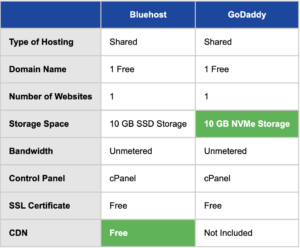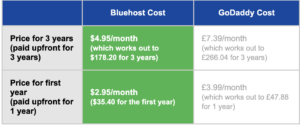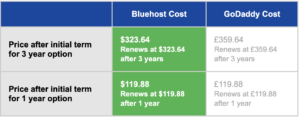To run a blog, you need web hosting. To run a successful blog, you need quality web hosting. Enter our topic today: Bluehost vs. GoDaddy and a detailed comparison of which is best.
There are hundreds of different web hosts, making it difficult to know which one to choose. When you’re new to blogging, their features can be bewildering.
Should you prioritize a host that offers a free SSL certificate? How much bandwidth do you need? What about storage space? It’s hard to know where to begin, but a good starting place is to choose from some of the most popular hosting services out there today.
Two of the most popular (and reputable) are Bluehost and GoDaddy. Each is very beginner-friendly, with competitive (budget-friendly) pricing—and they’re both widely respected.
So which one should you go for? I’ll share my recommendation first, then break down the differences between the features, performance, user experiences, customer support, and pricing they offer. Ready to finally choose your web host and make your website? Let’s go.
Bluehost vs GoDaddy (Comparison & Review): Which Web Host Should You Choose?
Disclosure: Please note that some of the links below are affiliate links and at no additional cost to you, I’ll earn a commission. Know that I only recommend products and services I’ve personally used and stand behind. When you use one of my affiliate links, the company compensates me, which helps me run this blog and keep my in-depth content free of charge for readers (like you).
Our Pick
If you’re in a hurry, you don’t need to read the rest of this article. Just choose Bluehost.
Bluehost is very reasonable (starting at $2.95/month) and has great customer support. Their cheapest plan has slightly better features than GoDaddy’s, too.
Even better, you can choose from many add-ons for your hosting and easily upgrade your hosting plan as your blog grows.
Bluehost is a hugely popular web hosting company, with millions of websites using its service. It’s also one of just three officially recommended WordPress hosting companies.
If you start a blog using WordPress, Bluehost is a very safe choice and certainly your best bet. If you’re ready to get your WordPress-powered blog off the ground today, head over to Bluehost and register your domain name today.
Want to Get Started with Bluehost Today?
Head over here to see their features, plans & pricing today—and get started for as little as $2.95/mo.
If you want to learn more about Bluehost’s options or want to see how it compares side-by-side with GoDaddy, let’s keep reading.
Features (Bluehost vs GoDaddy Plans)
Both Bluehost and GoDaddy offer a range of useful features for bloggers. Even their basic packages give you everything you need to get started.
Here’s a straightforward comparison graphic of how Bluehost vs GoDaddy stacks up (side-by-side) on their features:
Now, let’s dig into exactly how the key features of their cheapest plans compare to one another.
Type of Hosting
Whether you choose Bluehost, GoDaddy, or another cheap provider, you’ll be purchasing shared hosting. This means your website is stored on a big server (a computer) alongside lots of other people’s websites.
Shared hosting is suitable for most types of new websites. If your site begins to generate a lot of traffic or needs more resources in the future, you can upgrade to dedicated hosting, where you have your own server.
Winner: Tie
Domain Name
Your site’s domain name is its address on the web. All websites need a domain name. Both Bluehost and GoDaddy give you one for free. You’d normally need to pay around $15/year for a .com domain.
You can register your GoDaddy or Bluehost domain name at the same time you purchase your hosting plan. If you’re not quite ready to choose your domain name, you can register it at a later point, after you sign up for hosting.
Winner: Tie
Number of Websites
Both Bluehost and GoDaddy only let you create a single website using their cheapest plans. If you want to have several different websites, you’ll need a slightly more expensive plan.
Winner: Tie
Storage Space
Your website files occupy space on your website’s server, just like your files on your home computer.
If your website has hundreds of pages and many images, it will need much more storage space than a website with just a few pages and images.
Bluehost offers 10 GB of SSD storage space on their cheapest plan, and GoDaddy offers 10 GB of NVMe storage.
NVMe drives are much faster and more efficient than SSDs, making them the preferred choice for high-performance applications.
Winner: GoDaddy
Bandwidth
Bandwidth measures how much data is transferred from your website’s server to people’s computers. If lots of people visit your website, it’ll use more bandwidth.
Whether you opt for Bluehost vs GoDaddy, you’ll have unlimited bandwidth—even on their cheapest plans.
Note that both Bluehost and GoDaddy have fair usage policies. If your site uses far more bandwidth than most other sites on shared hosting, you’ll be asked to upgrade your plan.
Winner: Tie
Control Panel
Your web host’s control panel is how you change your web hosting settings. For instance, you can use the control panel to set up a new email address at your website domain.
Bluehost and GoDaddy use cPanel, the most common control panel software out there.
While cPanel can seem a little technical at times, there are many videos and tutorials online to help you understand how to use its different features.
Winner: Tie
SSL certificate (HTTPS)
Websites with an SSL certificate offer a secure connection over HTTPS instead of HTTP. Visitors to the site will see the secure padlock symbol in their web browser.
It’s really important to use SSL on your site, as Google prioritizes secure sites in the search results.
Bluehost offers a free SSL certificate that should be automatically installed and activated when you set up your site. (You can easily toggle it on and off in your Bluehost account.)
In the battle of GoDaddy versus Bluehost, GoDaddy doesn’t fall short. It offers a free SSL certificate for the lifetime of the hosting plan. The hassle-free certificates are automatically installed, validated, and renewed, providing robust 2048-bit encryption to ensure all transactions are secure.
Winner: Tie
CDN (Content Delivery Network)
A content delivery network (CDN) uses servers worldwide to help your website load as quickly as possible. This is a great way to speed up your site – which also helps with your SEO (search engine optimization).
Bluehost offers a free, built-in CDN. GoDaddy does not.
Winner: Bluehost
Performance
Website performance covers two key factors:
- Uptime (whether your website is available or not)
- Speed (how fast your website loads)
You don’t want to choose an unreliable hosting provider with a lot of downtime—where your site is offline.
All reputable web hosting companies will have a very high annual uptime: at least 99.9%.
Bluehost has an uptime of around 99.98% (meaning your website would be unavailable for about 1 hr and 45 minutes each year) and GoDaddy has an uptime of 99.99% (meaning your website would be unavailable for about 50 minutes each year).
GoDaddy also offers an uptime guarantee, under which you can receive credit up to 5% of your monthly fee if the uptime drops below 99.9%.
When it comes to speed, Bluehost is a little faster than GoDaddy: its load speed is 0.72s, and GoDaddy’s is 0.89s.
Those figures all mean that Bluehost and GoDaddy are high-performing web hosts. They’re reliable and fast—so you won’t need to worry about downtime or your site running slowly due to hosting issues. When it comes to the question of Bluehost vs GoDaddy on performance, they’ll both take good care of you.
Winner: Tie
User Experience
Both Bluehost and GoDaddy are straightforward to use and offer a lot of help for beginners. It’s easy to install WordPress on your site using both, though users tend to find the Bluehost interface more intuitive and a bit easier to learn overall.
Bluehost guides you through setting up your site and tailoring the help available to your level of experience.
Both Bluehost and GoDaddy include a built-in drag-and-drop WordPress site builder you can use if you wish. (You can also use WordPress’s default editor or other third-party tools.)
They both also use cPanel, the industry standard for control panel software.
Of course, as your site grows and brings in more traffic, you’ll likely want to add extras.
Bluehost has many add-ons, including the option to add Google Workspace, premium SSL certificates, SEO tools, ConstantContact plans, CodeGuard, and more.
GoDaddy also has several add-ons, but not with quite the same range of valuable features as Bluehost.
With both Bluehost and GoDaddy, you can upgrade to a more powerful hosting plan if you need more storage space or want to create multiple websites.
Winner: Bluehost
Customer Support
Bluehost and GoDaddy offer 24/7 live chat support and phone support, with their phone numbers posted on their websites.
Many hosts only offer phone support on premium plans (or make it tricky to access), which helps Bluehost and GoDaddy stand out.
Most new website owners will eventually have a question or issue with customer support. I’ve found Bluehost’s support team to be quicker to respond (and more helpful) than the GoDaddy support team.
Bluehost’s team members are supportive of new website owners. They’ll be happy to answer questions about WordPress, as well as issues related to your hosting itself.
Winner: Bluehost
Pricing
Web hosting pricing can be a bit confusing, so I’ll break everything down so you can make the best choice between GoDaddy and Bluehost.
Web hosts tend to quote prices per month, but with Bluehost and GoDaddy, you need to pay upfront for at least a year.
To get the lowest possible price with Bluehost, sign up 12 months in advance.
With GoDaddy, signing up 12 months in advance is also the cheapest.
After that, you’ll pay the standard rate for your web hosting, normally every year, two years, or three years, depending on what you initially chose as your term length.
The most important thing to understand is that you’ll face a larger bill after your initial term.
Hopefully, you’ll be making money from your website by then, but it’s still important to know about the increased pricing.
Here’s how the price looks for your initial term, depending on the term length you choose:
And here’s how the price looks after your initial term:
So, what does that mean in practice?
Winner: Bluehost
If you want to go with the most budget-friendly option, check out these monthly hosting providers that’ll allow you to pay month-to-month for your hosting.
GoDaddy vs. Bluehost: Which Web Host Should You Choose Today?
Both Bluehost and GoDaddy are large, reputable, high-quality web hosts. Both have millions of customers and many years of experience hosting websites.
However, Bluehost has the edge over GoDaddy, with better customer support, add-on options, and a more user-friendly experience. It’s also an official WordPress host, making it a perfect choice for running a WordPress site.
Ready to get your website underway? Go and sign up for Bluehost or GoDaddy hosting now.
They’ll guide you through each step—and you’ll have your website up and running in no time.
Want to Build Your Website with WordPress?
Follow along with my guide—3 Easy Steps to Make a Website.



Booking marking this one. Great article with tons of important information…thanks Ryan!
Glad to hear that, Wendy! Thanks for the kind words too 🙂
Rob, affiliate sales may drive your endorsement of these two host platforms, but honestly, I would not recommend Go Daddy! to my worst enemy, and many web developers will tell you Bluehost is where you get what little you pay for.
For more than the last decade, GD has had security issues, particularly with WordPress sites.
I’ve been using 1and1, now Ionos since 2004 and never had a problem with anything on my sites. And I am not an affiliate of theirs. Probably won’t ever be, so I can maintain my objectivity.
Donald, I’m from Russia and there are none of the above suppliers as BH, GD, or 1&1 Ionos on my list yet. But I’d definitely pick BH in case of running a blogging business worldwide. It’s subjectively, however, I’ve got some feedback on the Russian web concerning 1&1 Ionos which has tariff plan issues, dashboard menu issues, billing issues, support issues. Where there’s a word “issues” stands for a real headache.
For example:
-No client tech support (no responses to requests).
-Trial of 30 day period doesn’t mean that you will return your money, although 1&1 states that 1 Mo is free then they increase tariff.
-If there is no payment your products will be blocked.
IMO, being in the East, I’d rather think twice to post and offer 1&1 Web Host.
This is not an imperative piece of advice. Check it before use on the Web for yourself.
Hey Donald! I appreciate your take on this. I won’t disagree with you on the distinction you made about web developers not using a platform like Bluehost (or GoDaddy)… however these two hosting platforms are for beginners to blogging/owning websites—not web developers. And in that rite, I stand behind them as being great choices that go to great lengths in supporting their customers with tech setup along the way.
Maybe in Europe or US, wherever you are operating from, Bluehost may be performing well, but in india its trash, godaddy is the cheapest yet the best, bluehost is 20% more costly, slow for a normal wordpress site, the fact that it is recommended by wordpress turns itself upside down if you ask anybody in India